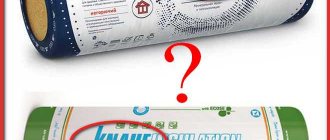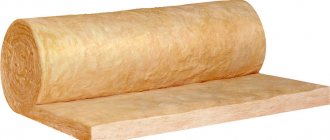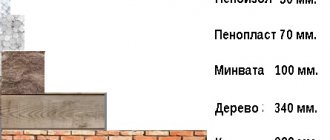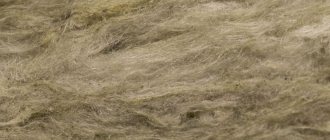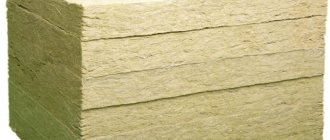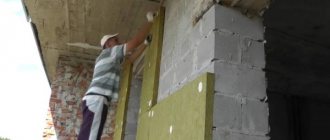With the advent of the first cold weather, people living in private houses begin to think about insulating their homes. They are faced with the question: which is better, mineral wool or stone wool? Both belong to the same class of insulation, but each has its own advantages, disadvantages and other qualities, and there are many differences that people pay attention to when choosing.
The manufacturer market is huge, the range is varied and it is necessary to understand all the criteria. Therefore, in the article we will talk about the production of each of the wools, the differences and main characteristics, the most successful and not qualities for insulating different types of houses - urban and rural.
Construction work using mineral wool
Content
If it is necessary to insulate the walls of a house or apartment, the first question is the choice of materials for the work. One of the most popular options is insulating a house with mineral wool. This method has earned its popularity due to its low cost, external indicators and performance characteristics. But to carry out the work correctly, you must first select the right type of material. We decided to look at this issue in more detail and decide which mineral wool is better to choose and what to pay attention to when choosing.
Step-by-step instructions for insulating walls outside with your own hands
After preparing the materials, the insulated area of the house is calculated. Step-by-step instructions for insulating a house with a ventilated gap are presented in the video
The video contains recommendations that will help you easily insulate a building.
When everything is ready, the mineral wool is installed using the following technology:
- The walls are being prepared.
- A vapor-tight membrane is installed.
- Wooden or metal slats are mounted.
- Insulation is installed in the installed slats.
- A waterproofing film is installed.
- A ventilated gap is created.
Preparation begins with cleaning the walls from plaster layers if the wall is concrete or brick. The wooden surface is impregnated with an antiseptic to protect against mold. Window slopes and platbands are dismantled.
The wall must be completely dry before starting work. Therefore, insulation work cannot be carried out if there is high humidity outside.
The vapor-tight membrane is installed with the smooth side facing the insulation. Its installation is carried out to remove vapors from the wall of the building. The insulation can be installed without the use of such waterproofing, but only if the surface is perfectly flat.
Then vertical slats are mounted to the wall of the building using self-tapping screws.
Read how to choose self-tapping screws here.
To determine the distance between the slats, the width of the insulation sheets is taken into account. For example, if wooden blocks measuring 50x50 mm are installed, and the width of the mineral wool is 600 mm, then this distance will be equal to 598 mm. The installed material is easily compressed when installed between the slats, and then straightens out, taking its original shape.
Insulation is installed in the spacer between the slats. If necessary, the mineral wool is cut with a knife to the required size. If installation is carried out on a wooden wall, the material is secured with dowels. And if on a concrete surface or on brickwork, then the use of glue is allowed.
The insulation should fit tightly to the wall, without gaps between the slats. First, whole pieces of mineral wool are installed, and then pieces are used in places where cracks occur, around window or door openings.
If necessary, you can use a second layer of insulation. It is necessary to ensure that the seams of the 2 layers of insulation do not coincide in order to avoid the occurrence of an air gap.
The waterproofing film is installed on top of the insulation. It ensures moisture removal from the material. The film is secured to the slats using dowels. The seams are additionally taped with special metallized tape.
The ventilated gap is mounted on top of the slats. For this purpose, additional counter rails are installed. Various finishing materials are then installed on them: block house or siding.
Types of mineral wool
Such material can be presented in different forms, which differ in composition, shape, density and other characteristics. The only common factor for all is the low density and fibrous structure, which ensures its characteristics. But let's take a closer look at the types of materials.
If you are planning to insulate walls with mineral wool, then first you should understand its classification. It is divided into different types depending on:
- Composition.
- Release form.
- Density brand.
Let's take a closer look at each of the classification options.
Mats, cylinders and mineral wool for blowing
Mineral wool boards are small in size and easy to install yourself. Mats differ from them in their larger dimensions - 7-12 m. It is better to work with such material with a partner. The significant area of insulation allows you to quickly lay a layer of thermal insulation on the ceiling or wall. As a result, there are a minimum of seams that need to be sealed. When transporting, the mats are rolled into a roll; after purchasing and cutting the packaging, they easily restore their shape.
Cylinders are used for thermal insulation of pipelines. The rigidity of a structure made of cotton wool can be increased by using a reinforcing mesh, and it is protected from the outside by foil. Product dimensions: internal diameter from 12 to 325 mm, length 1.2 m, thickness from 20 to 90 mm.
Fiberglass-based material is used without forming rolls or slabs; it is blown onto the surface to be insulated using special equipment. This technology allows you to isolate complex structural elements of the roof.
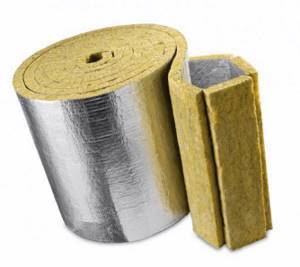
Types of cotton wool by composition
Various components are used to produce the material, and depending on this, it can be presented in the following forms:
- Stone wool. Made from basalt and gabbro, it is often also called basalt. Cotton wool consists of 80% rock and synthetic binders.
- Quartz. Appeared on the market relatively recently. It is characterized by a higher level of elasticity compared to basalt.
- Slag-like. Similar to stone, but made from waste from the metallurgical industry. It has a lower price and technical characteristics compared to its analogue.
- Glass wool. The most popular option, which is made from glass and sand. It has a high level of resistance to chemical attack.
The characteristics of each type depend on the proportion of the main components. Production is regulated by state standards.
Fiber material: basalt, glass and slag
Glass, stone and slag are used as raw materials for the production of mineral wool:
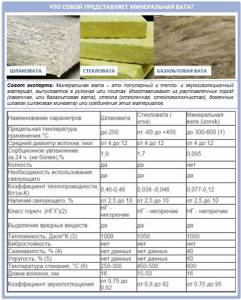
Slag wool: light and soft
Slag wool is extremely rarely used for roof insulation, because it is made from blast furnace slag, which negatively affects human health. The fiber size is about 16 mm, thickness from 4 to 12 microns.
Another disadvantage is that the fibers are very brittle, and you can only handle such cotton wool with gloves and carefully. But due to its flexibility and uniform thickness, it is convenient to work with the wool itself. In addition, slag wool is lightweight and does not create a load on the roof structure.
Slag wool has an airy structure, with thermal conductivity in the range of 0.046-0.048 W/mK. And because of its structure, it has high vapor permeability and hygroscopicity, and therefore with such insulation you need to pay special attention to insulation.
Fire safety is quite acceptable, with a permissible temperature of up to 300°C, because wood burns at a temperature of 320°C. The service life of slag wool is 50 years, if we are talking about high-quality products.
Glass wool: resilient but scratchy
Glass wool is obtained by melting quartz sand or glass fragments. The glass is blown at high temperatures into very thin fibers, which are combined to form cotton wool. The finished glass wool has a light yellow color and is very unpleasant when touched and inhaled, because we are talking about microscopic fragments that remain on the threads. In addition, the binding element of such fibers is phenol-formaldehyde compounds, which also will not affect the health of household members.
The thermal conductivity of glass wool is in the range of 0.029-0.050 W/mK. Let's say the indicator is quite low, and all because the fibers are too thin - from 4 microns thick. Also, due to its special structure, it is hygroscopic at high air humidity. The density is close to slag.
Surely you know that they don’t like glass wool because its small fragments get on unprotected skin and eyes and cause severe irritation. Because of these features, special glasses, gloves and a protective suit are worn during the installation process. But, if glass wool does get on the skin, it should be quickly washed off with cold water.
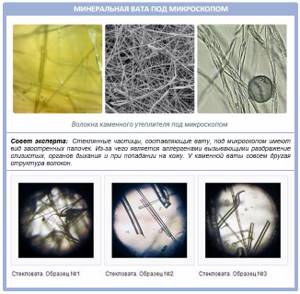
If we are talking about an attic, then glass wool is quite suitable in terms of fire safety; its permissible heating temperature is 450°C. Therefore, you can easily use this material to create a cozy and safe space. And to prevent small, sharp fibers that can be carried by ventilation, ensure reliable vapor barrier joints.
Stone wool: heavy, but environmentally friendly
But stone wool is much safer, because it is made from rock. It comes in a variety of shades, from yellow-brown to greenish. For production, basalt is used, which is also melted into small fibers. Unlike glass, basalt wool is heavier, more elastic and fire-resistant:
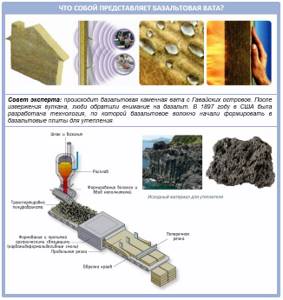
Basalt minislabs have a thermal conductivity of 0.076-0.12 W/mK - this is the highest indicator. The thickness of the fibers is up to 12 microns, and the length of the fibers is from 16 mm. It has an airy structure, high vapor permeability and the need for protection from moisture.
And there is such an interesting feature: the denser the wool, the less it disintegrates during operation and the less fine dust, and the easier it is to install it on vertical surfaces. Moreover, high-quality basalt wool does not prick:
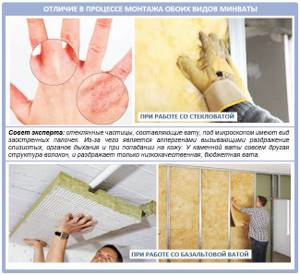
Basalt fibers are the safest type of all mineral fibers. If you choose mineral wool for attic insulation, you need one that will not rest when inserted and does not need to be twisted to push it into the desired space:
The particular value of basalt wool is its high fire safety, because the heating temperature here is 600°C, which is ideal for a wooden rafter system. Thanks to the insulation, it is even protected from fire: they are simply laid in two layers, and the rafters are completely protected from accidental fire. In addition, basalt wool has some of the highest sound insulation rates.
In terms of density, basalt wool ranges from the lowest to the highest, depending on what tasks are set for it. And its price depends on its density. If you are insulating a pitched roof, medium-density wool is suitable. And basalt wool will last more than 50 years.
By the way, in terms of thermal insulation of the type of wool, both glass and stone are quite close:
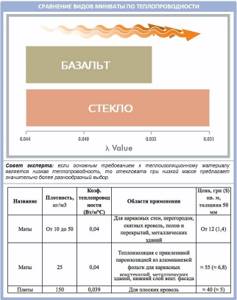
Density classification
You can also distinguish three classes of insulation by density, namely:
- P-75 - insulation has a density of 75 kg/m. It is not intended for heavy loads, and therefore is used only for horizontal surfaces without load.
- P-150 and P-125. Semi-rigid insulation that is suitable for vertical, horizontal and inclined surfaces.
- PZh-175, PPZh-200. Rigid slabs that practically do not shrink. Used for insulation of loaded structures.
Features of mineral wool
If you plan to insulate the facade with mineral wool, then you should take into account its characteristics, namely:
- Low level of strength.
- Good vapor permeability.
- A small mass.
- Low thermal conductivity coefficient.
- Chemical resistance.
- Fire resistance.
- Non-toxic.
- Fire safety.
- Frost resistance.
- Good sound insulation.
- High level of water absorption.
All these characteristics make mineral wool the best option for insulation, and considering that you can carry out the work yourself, since the technology is quite simple, this is simply an ideal option.
Application of mineral wool
Mineral wool of various types is used in many areas, in particular the following can be distinguished:
- Insulation of apartments and houses.
- Insulation of utilities.
- Carrying out insulation of equipment.
Thus, using such material as insulation will help you significantly reduce heating costs.
Here you can read about an alternative method of thermal insulation and how to protect thermal insulation from moisture:
- Foam plastic for insulation. Types and applications
- Why do you need a vapor barrier and which side should you lay it on?
Subtleties of insulating a house under construction
There are several rules that help achieve maximum effect from this work when constructing a new building. A few tips will help you properly insulate your home:
- Insulation boards are installed along the entire façade of the house.
- Fastenings in the form of an anchor are drilled into the wall. They are necessary to securely hold the material.
- The slab is threaded onto an anchor. Special fasteners are locked to the plate with clamps.
- Above the insulation layer, a brick wall is constructed, intended for facing purposes.
- To grout the joints, use a solution of sand and cement or use beautiful plaster.
